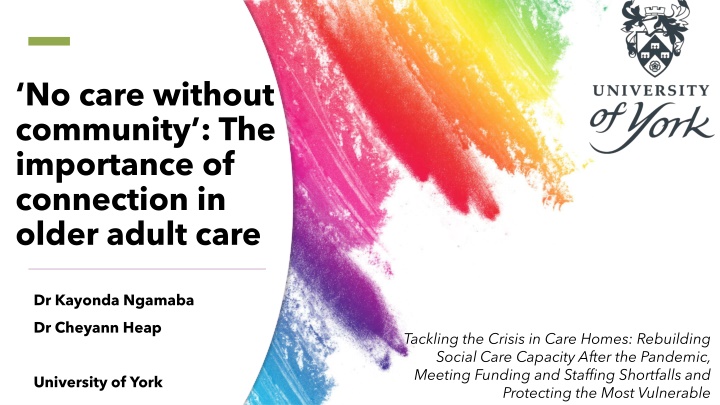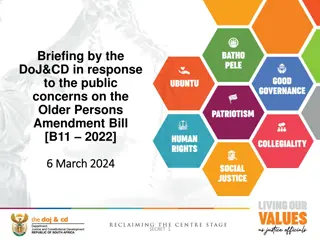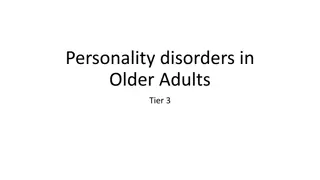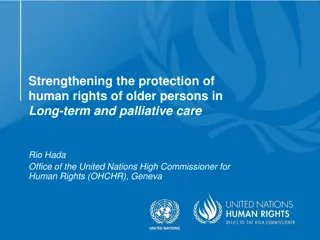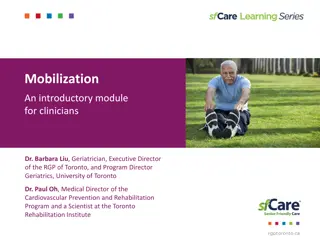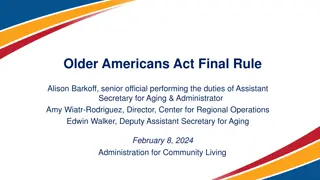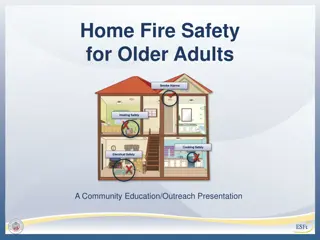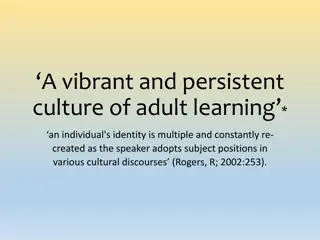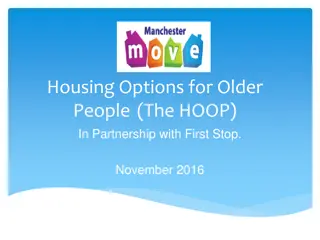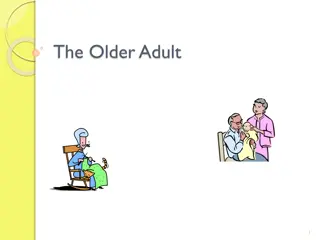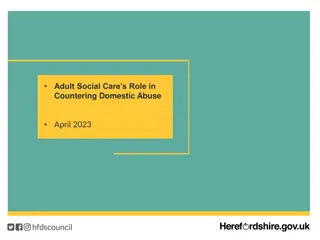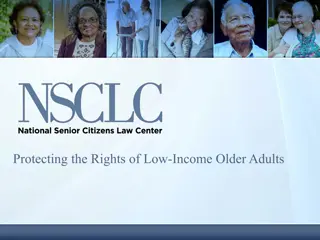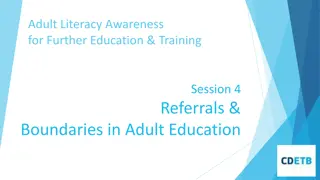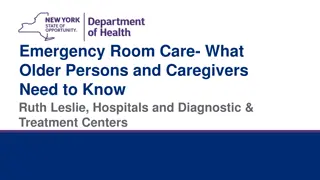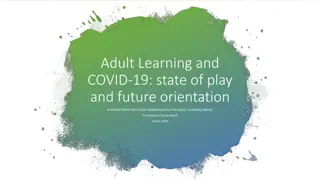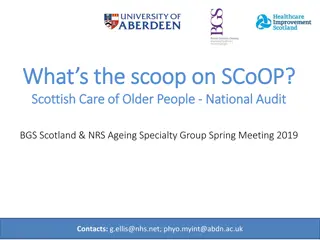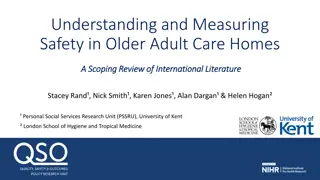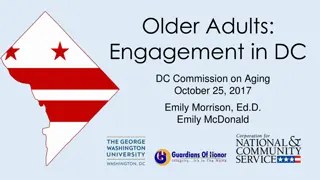Importance of Connection in Older Adult Care: Building Community Relationships
Discussing the significance of interpersonal relationships and community engagement in older adult care, exploring the impact of the pandemic, staff well-being, and person-centered approaches to enhance care quality and resilience.
Uploaded on Apr 04, 2025 | 0 Views
Download Presentation

Please find below an Image/Link to download the presentation.
The content on the website is provided AS IS for your information and personal use only. It may not be sold, licensed, or shared on other websites without obtaining consent from the author.If you encounter any issues during the download, it is possible that the publisher has removed the file from their server.
You are allowed to download the files provided on this website for personal or commercial use, subject to the condition that they are used lawfully. All files are the property of their respective owners.
The content on the website is provided AS IS for your information and personal use only. It may not be sold, licensed, or shared on other websites without obtaining consent from the author.
E N D
Presentation Transcript
No care without community : The importance of connection in older adult care Dr Kayonda Ngamaba Dr Cheyann Heap Tackling the Crisis in Care Homes: Rebuilding Social Care Capacity After the Pandemic, Meeting Funding and Staffing Shortfalls and Protecting the Most Vulnerable University of York
Overview Background and context Case study: Benefits of Running a Multicultural Singing Project Among Older Adults in a Naturalistic Residential Environment (Ngamaba & Heap, 2022) What have we learned? How we can take forward our example of community engagement
The covid-19 pandemic crisis or resilience? Care homes worked together; Some relationships became closer; Community networking & resources (Marshall et al., 2021) Opportunities for engagement, physical touch, person-centred care, and positive communication / small talk (Ferdous, 2021) Good relationships with caregivers reduced covid- 19 stress (Chee, 2020) Best practice maintain social connections, strengthen social connections esp between residents and outside world (Beogo et al., 2022) Move to social-relational fewer covid-19 deaths than in medical / institutional care models (Power & Carson, 2021) Care staff tend to have a relational-moral and wellbeing-focused way of working (Dohmen et al., 2016; Dutch study)
Interpersonal relationships are key Therapeutic reciprocity (Moniz-Cook, 1997) Staff: interpersonal skills, commitment, awareness/reflection Organisation: Staff & physical space; mid-managers (esp permission); person-centred organisation (security & support); person-centred culture (reduced focus on top-down tasks & clinical outcomes) Ryan, 2022 Relationship-centred like the Nolan s Senses Framework and positive communication can reduce challenging behaviour (Gillis et al., 2019; Passalacqua & Harwood, 2012). Burnout related to staff negative expectations / perceptions of age, illness and dementia (Mandiracioglu et al., 2006) Person-centred care increases staff sense of competence (Mullan, 2016) But sense of reward may come more from positive self-as-carer (Hillman, 2001)
Older Adult-Centred Care Autonomy, dignity, unique needs and social environment (Kayabadi et al., 2020) Reciprocity value (Ryan & Nolan, 2019) Non-medical, mutually caring human relationships (Heap & Wolverson, 2020)
Singing in groups in care homes Organised activities genuinely person-centred? A man, who couldn t sing, was singing at the residents. He failed to interact with the people he was entertaining. No eye contact was made and there was a distinct lack of dialogue with the residents (Eyers, 2012; p. 68)
Singing in groups Reduces cortisol (Cambell & Bodkin-Allen, 2022) Release endorphins (Klang et al., 2018) Connectedness w/ oxytocin (Good & Russo, 2022) Quick group bonding (Weinsten et al., 2016) Memories / nostalgia Motivation, attention, behavioural synchronicity, and a collective achievement
Case study Kayonda Ngamaba & Chey Heap Ngamaba, K. H., & Heap, C. J. (2022). Benefits of Running a Multicultural Singing Project Among Older Adults in a Naturalistic Residential Environment: Case Studies of Four Residential Care Homes in England. Journal of Gerontological Nursing, 48(9). https://doi.org/10.3928/00989134-20220808-04
Multicultural singing intervention (Ngamaba & Heap, 2022) Local church community connection (predominantly African refugees), mixed ages 4 care homes in Bolton Hospital, care home, nursing home x 2 With and without dementia Long and short term stays Predominantly White-British Making a connection (talk to manager)
The singing intervention Risk assessment Training for choir Setting a schedule Consent prior to visit and ongoing Communal area setup (& instruments!) Members introduce themselves and distribute written song lyrics Residents can come and go, watch or join Choir leader asks to share experience after song
Feedback on the project Care home 1: Our resident really enjoys; the choir makes them interact with singing and clapping; very enjoyable . Makes the patients enjoy and get involved . Care home 2: Happy smiling faces good mood. Very good keep up the good singing . Care home 3: I really enjoy your visit. Thank you for singing Happy Birthday; it really made my day . Care home 4: All service users enjoyed this. Greatly improved their moods and got them up dancing. This is a good idea for the elderly . Amazing, brightens up the lives of people waiting for treatment .
Residents enjoyed a group activity, socialised, reminisced, and became at ease with each other and outsiders (an African choir). Community cohesion & mutual benefit The project helped to break down psychological barriers between younger choir members and care home residents, and between African refugees and a largely White British community. Both care home residents and staff reported personal benefits. Acts of giving and kindness can improve wellbeing; choir members reported positive emotional impact from the project.
Our Project and Older Adult-Centred Care Autonomy choice of song, choice whether to participate Dignity respectful introductions, done with not done to Unique needs every person participates as they wish, sing or not Social environment focus on the social connection Reciprocity teaching the choir new songs! Breaking barriers about older people
What have we learned? Using this knowledge moving forward
Implications for the care home crisis Not just physical resource - culture change is needed Social-relational, not medical Community connections & capacity building Policies that enable fun, safety, connection & creativity Relationships within and outside care homes Care homes and residents can give something back to the community and break social barriers The future is with the community
Take home message This intervention helps to Tackle loneliness & social isolation Target local people to be involved in ASC Local Immigrants who are usually better workers Involve children/youth Link to ASC as potential employees Give a Break to Staff who are exhausted: Well-Being & Job satisfaction of staff
Thank you! Questions? Dr Kayonda Ngamaba, Research Fellow Kayonda.ngamaba@york.ac.uk Dr Cheyann Heap, Research Associate cheyann.heap@york.ac.uk
References Beogo, I., Tchouaket, E. N., Sia, D., Bationo, N. J. C., Collin, S., Tapp, D., ... & Gagnon, M. P. (2022). Promising best practices implemented in long-term care homes during COVID-19 pandemic to address social isolation and loneliness: a scoping review protocol. BMJ open, 12(1), e053894. Campbell, Q., Bodkin-Allen, S., & Swain, N. (2022). Group singing improves both physical and psychological wellbeing in people with and without chronic health conditions: a narrative review. Journal of Health Psychology, 27(8), 1897-1912. Campbell, Q., Bodkin-Allen, S., & Swain, N. (2022). Group singing improves both physical and psychological wellbeing in people with and without chronic health conditions: a narrative review. Journal of Health Psychology, 27(8), 1897-1912. Chee, S. Y. (2020). COVID-19 pandemic: The lived experiences of older adults in aged care homes. Millennial Asia, 11(3), 299-317. Dohmen, M. D., van den Eijnde, C., Thielman, C. L., Lindenberg, J., Huijg, J. M., & Abma, T. A. (2022). Good Care during COVID-19: A Narrative Approach to Care Home Staff s Experiences of the Pandemic. International Journal of Environmental Research and Public Health, 19(4), 2106. Eyers, I., Arber, S., Luff, R., Young, E., & Ellmers, T. (2012). Rhetoric and reality of daily life in English care homes: the role of organised activities. International Journal of Ageing and Later Life, 7(1), 53-78. Ferdous, F. (2021). Social Distancing vs Social Interaction for Older Adults at Long-Term Care Facilities in the Midst of the COVID-19 Pandemic: A Rapid Review and Synthesis of Action Plans. INQUIRY: The Journal of Health Care Organization, Provision, and Financing, 58, 00469580211044287. Gillis, K., Lahaye, H., Dom, S., Lips, D., Arnouts, H., & Van Bogaert, P. (2019). A person centred team approach targeting agitated and aggressive behaviour amongst nursing home residents with dementia using the senses framework. International journal of older people nursing, 14(4), e12269. Good, A., & Russo, F. A. (2022). Changes in mood, oxytocin, and cortisol following group and individual singing: A pilot study. Psychology of Music, 50(4), 1340-1347. Hillman, J., Skoloda, T. E., Angelini, F., & Stricker, G. (2001). The moderating effect of aggressive problem behaviors in the generation of more positive attitudes toward nursing home residents. Aging & mental health, 5(3), 282-288. Kabadayi, S., Hu, K., Lee, Y., Hanks, L., Walsman, M., & Dobrzykowski, D. (2020). Fostering older adult care experiences to maximize well-being outcomes: A conceptual framework. Journal of Service Management. Kang, J., Scholp, A., & Jiang, J. J. (2018). A review of the physiological effects and mechanisms of singing. Journal of Voice, 32(4), 390-395.
References Mandiracioglu, A., & Cam, O. (2006). Violence exposure and burn-out among Turkish nursing home staff. Occupational medicine, 56(7), 501-503. Marshall, F., Gordon, A., Gladman, J. R., & Bishop, S. (2021). Care homes, their communities, and resilience in the face of the COVID-19 pandemic: interim findings from a qualitative study. BMC geriatrics, 21(1), 1-10. Moniz Cook, E., Clin, D., Millington, D., & Silver, M. (1997). Residential care for older people: job satisfaction and psychological health in care staff. Health & social care in the community, 5(2), 124-133. Mullan, M. A., & Sullivan, K. A. (2016). Positive attitudes and person-centred care predict of sense of competence in dementia care staff. Aging & mental health, 20(4), 407-414. Ngamaba, K. H., & Heap, C. (2022). Benefits of Running a Multicultural Singing Project Among Older Adults in a Naturalistic Residential Environment: Case Studies of Four Residential Care Homes in England. Journal of Gerontological Nursing, 48(9), 52-53. Passalacqua, S. A., & Harwood, J. (2012). VIPS communication skills training for paraprofessional dementia caregivers: an intervention to increase person-centered dementia care. Clinical Gerontologist, 35(5), 425-445. Power, G. A., & Carson, J. (2022, January). The promise of transformed long-term care homes: Evidence from the pandemic. In Healthcare Management Forum (Vol. 35, No. 1, pp. 25-28). Sage CA: Los Angeles, CA: SAGE Publications. Ryan, T. (2022). Facilitators of person and relationship centred care in nursing. Nursing Open, 9(2), 892-899. Ryan, T., & Nolan, M. (2019). Relationships, values and dementia care: Promoting reciprocity and interdependence. In Textbook of Dementia Care (pp. 11-19). Routledge. Weinstein, D., Launay, J., Pearce, E., Dunbar, R. I., & Stewart, L. (2016). Singing and social bonding: changes in connectivity and pain threshold as a function of group size. Evolution and Human Behavior, 37(2), 152-158. Weinstein, D., Launay, J., Pearce, E., Dunbar, R. I., & Stewart, L. (2016). Singing and social bonding: changes in connectivity and pain threshold as a function of group size. Evolution and Human Behavior, 37(2), 152-158.
